Top 5 Successful MVP Cases and 10 Lessons You Can Learn from Them
Published: May 2, 2022
17 min read
In this article, you'll learn:
1
🏠 Airbnb: first — the Problem, then — the Solution
2
📦 Dropbox: the Marketing Trick that Changed Everything
3
📧 Groupon: Look at Your Users
4
📆 Buffer: Test Before Coding
5
🚕 Uber: Scale Gradually
6
💡 Takeaways
If you ended up on the article about Minimum Viable Product famous examples, you’re likely familiar with this concept. Yet, often it’s still unclear how exactly you should use it and what benefits you can expect to get.
So let’s switch from theory to practice. We’re going to look at how today’s market leaders used the MVP concept to develop their ideas from tentative assumptions into million-dollar companies. And, moreover, find out what lessons from their mistakes and achievements we can learn right now.
In case you would like to refresh your memory or get a deeper understanding of the MVP concept, we recommend checking the following articles on our blog:
🏠 Airbnb: first — the Problem, then — the Solution
Modern Airbnb website has almost nothing in common with its initial version. However, this very first version is usually considered as one of the classic examples of a Minimum Viable Product. Here’s why!
The Story 📖
Startup Teams often wonder how much minimum their product should be. Well, I guess Airbnb’s Minimum Viable Product case study gives an irrefragable answer to this question.
The story begins in 2007. Friends from San Francisco decided “to make a few bucks” during the IDSA Conference that brought many visitors to the city. Foreseeing the hotel overbooking issue, they’ve decided to rent an air bad to visitors.
To promote the offer, guys made up a simple web page:
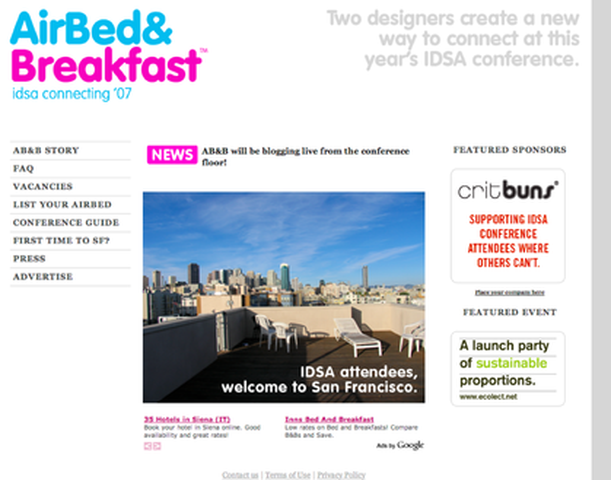
One of the first Airbnb's iterations
The webpage can be considered as a Minimum Viable Product definition by itself: no interactive maps, no options to choose from, no online payments. Only a few photos of the place, contacts, and address.
Yet, it was enough to get 3 paying customers, raise $240 and — eureka! — catch the idea that they’ve possibly stumbled upon a goldmine. However, they haven’t woken up as millionaires the next morning.
The guys have made a few more similar attempts during the 2008 Democratic National Convention and 2008 SXSW, at the same time reaching out to investors. None of that was much of a success.
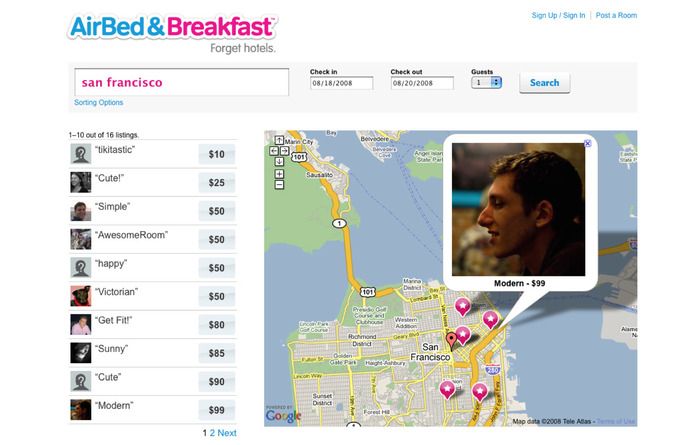
Airbnb's Minimum Viable Product Website Example
2009 was the story-changing year for the company. The guys were finally noticed by Paul Graham, a VC and Y Combinator co-founder, who invited them to join the accelerator.
From that moment on, they’ve redesigned their website, changed the name from Air Bed & Breakfast to laconic Airbnb and took a new approach to add properties from other owners. Eventually, this site became one of the most famous Minimum Viable Product website examples.
The renewed strategy helped to double their weekly income from $200 to $400.
Interesting fact: the guys visited all their New York hosts to take professional photos of their places and write first-hand reviews.
In April 2009, Airbnb received its first major investment of $600,000. That was the moment when they finally enabled the rapid growth and made their way to global success.
The Lessons 👨🎓
What can you learn from Airbnb’s Minimum Viable Product examples?
💡 Lesson # 1: An MVP can help you validate your idea but you’ll have to look for growth opportunities on your own.
Some think that if an MVP doesn’t bring you a hundred thousand users and a few million-dollar investments, it is a fail.
However, as you can learn from Airbnb’s examples of a Minimum Viable Product, this concept helps to validate whether there’s a need for your product at all. But after you confirm it, there still may be a long way ahead.
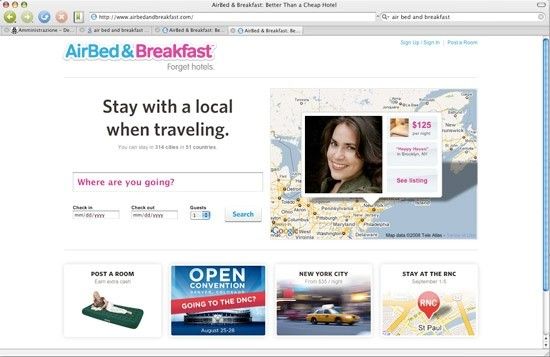
Far from how we know it now, isn't it?
💡 Lesson # 2: MVPs can be used to validate different parts of your Startup.
As a rule of thumb, you can create an MVP to validate your idea, solution or both of that. However, it’s recommended to start with the idea validation. Why? Because if you’re trying to solve the problem no one has or no one is ready to pay for, there’s not much sense in creating a solution to it, right?
Let’s get back to the story. When the guys launched the very first version of the website, they were testing the problem.
Would people want to stay at someone’s home instead of a hotel? Would they pay for it?
However, their MVP could hardly be considered as a solution. You couldn’t choose between different properties, leave or read reviews, pay online or even book via email.
Yet, after validating the initial idea and adding a few extra features, they’ve moved to the step of the solution validation. During this step, they were checking whether the product is able to solve the problem using the minimum set of viable features. Only then it would turn into one of the MVP software examples.
If you're interested in learning more about the Airbnb's way to success, watch this episode of the Y Combinator Startup School with Brian Chesky, the company's founder:
📦 Dropbox: the Marketing Trick that Changed Everything
Just like Airbnb, Dropbox can often be found on the list of typical Minimum Viable Product examples. It shows that the right strategy for reaching out to the audience is not less important than the product development itself.
The Story 📖
The idea for Dropbox was born out of personal experience. Drew Houston, the company’s co-founder and CEO, was tired of constantly carrying his thumb driver and bombarding himself with emails to move files between different devices.
The day when he forgot his flash drive at home one more time was the day when the first lines of Dropbox’s code were written.
However, it was quite a tricky technical task right from the start. Full implementation would require building an actual hardware infrastructure, integration with different computer and mobile platforms (iOS and Android), etc. All in all, it would take months to develop a product that no one may actually want. That was something he couldn’t afford to build on his own.

The story of Dropbox is the story about huge marketing success
Houston then applied to Y Combinator. Despite his idea was appreciated, to get into the accelerator he needed a co-founder. Drew said that finding one was like a shotgun wedding: “It was sort of like getting married on the first or second date”.
Interesting fact: you can check Drew Houston’s application for Y Combinator here.
The future co-founder reached out to him after seeing Dropbox’s demo and after a 2-hour сonversation, he became a part of the team.
Then the guys got noticed by Michael Moritz, Sequoia Capital’s chairman, and received $1.2 million for further development. In a year they publicly launched the product and that’s when one of the most prominent moments in Dropbox’s history happened.
To attract new users, the company created a few short demo videos. Instead of talking about some deep technical aspects of Dropbox or drawing a parallel with competitors, they’ve demonstrated a few real use cases. Videos were short, informative and generously flavored with humor:
The videos went viral, bringing hundreds of thousands of new customers to the service.
They’ve also introduced a referral program. It turned out to be even more successful. Dropbox offered free extra space for inviting a friend both to you and a person who signed up after following the link. That’s launched a new wave of viral shares, keeping the company’s growth rate absolutely organic, high and free eventually turning Dropbox into a product and company as we know it now.
The Lessons 👩🎓
“But,” you may say, “working on a product for a year with $1.2 million on your bank account hardly seems to fall in line with other MVP examples”.
However, one of the top challenges for Startups is not only to create a good product but come up with the right channel to promote it among potential customers. Dropbox did it well.
💡 Lesson # 3: A good Product with no promo is a bad Product.
Getting very first customers should be a natural process for a good Startup. After all, if you have developed a product to solve a specific problem, you know that the problem exists. And if you know that the problem exists, you should also know the people who have it.
Yet, reaching out to a wider audience usually requires some extra effort. Small Startup companies usually don’t have enough resources to invest them in advertising. Moreover, viral content is always highly appreciated since its promotional impact is much higher than creation costs.
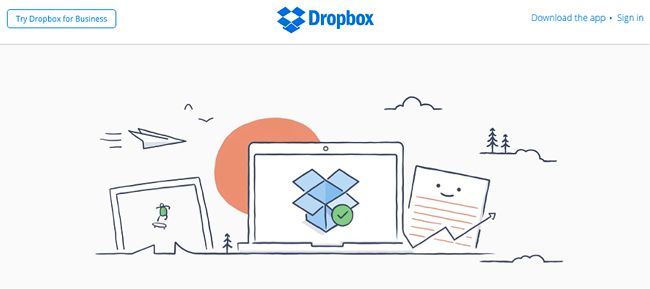
Here are a few tips on how you create content that can go viral:
- Make it fun & catchy. People like sharing content that makes them laugh (just like Dropbox’s videos). However, don’t overdo so as not to scare people off.
- Encourage sharing. Offer some extra value for people who share information about your product. For example, Dropbox offered extra free space for inviting a friend.
- Keep it short and dynamic. Like it or not but viral content is often fast-food content. People will unlikely read a 10-page story or a 15-minute video.
💡 Lesson # 4: Look for Startup ideas around. Literally.
Both Airbnb and Dropbox ideas come from the personal experience of its founders. It’s a good idea to remember when you’ll be thinking over your own Startup project.
Solving a problem that you, your family or friends have, may provide you with a bunch of advantages.
For example, it gives you a better understanding of the problem. When you know it from the inside, you’re aware of the smallest detail: what a need people try to fulfill, why alternative solutions don’t satisfy them, etc.
Also, you’ll have a few names on your list of potential customers right from the start. Despite they can’t be considered as the only source to validate your MVP examples, they still may give you valuable feedback.
After all, you will just have more motivation to do your best because, for example, forgetting your ******* flash driver at home every damn time drives you mad 🙂
📧 Groupon: Look at Your Users
If you’re looking for a “pre-launch page” MVP examples, Groupon perfectly fits this description. Let’s take a look!
The Story 📖
As it often happens, Groupon was built from the mistakes made on previous projects. Andrew Mason, the founder of both services, describes his first big project, The Point, as a “broader version of Groupon”.
The goal of the website was to bring people in groups so they can do together something that is too big for a person to solve alone. It could be anything from running a political campaign or a boycott to organizing a charity event. One of the ways people used The Point was collective buying.
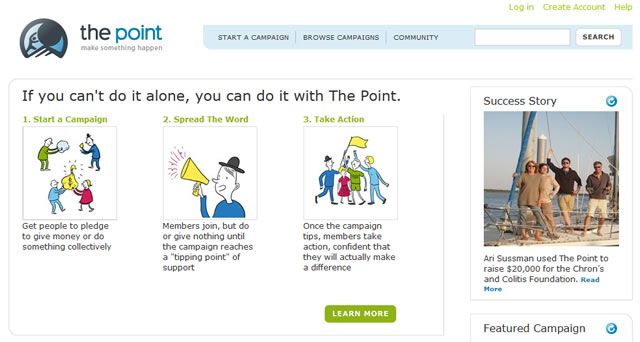
An MVP of the first Andrew's product, The Point.
However, The Point didn’t skyrocket due to a number of reasons. So Andrew Mason got on the list of Minimum Viable Product famous examples with his another startup, Groupon.
The project took 10x less time to launch. Moreover, it was quite simple from the tech perspective. Not to say primitive.
The service started as a WordPress blog. To generate coupons they’ve used FileMaker, a simple MacOS application, and then would run a script to email the coupon PDF to people on the mailing list.
But the truth is that they didn’t need any sophisticated product. At that moment, their goal was to validate the idea and gather feedback.
The service turned out to be popular, letting them build the voucher system and backend, and eventually become one of the most successful MVP software examples ever.
The Lessons 👨🎓
There’s quite a lot you can learn from both Andrew Mason’s projects. Moreover, in this interview, he underlines a few important conclusions for Groupon that he managed to draw out of his failure with The Point.
💡 Lesson # 5: Keep your TTM (Time to Market) short.
The Minimum Viable Product definition itself is all about reaching potential customers and validating your idea as fast as possible.
Just to compare: Andrew launched Groupon in 1 month while it took about 11 months for The Point.
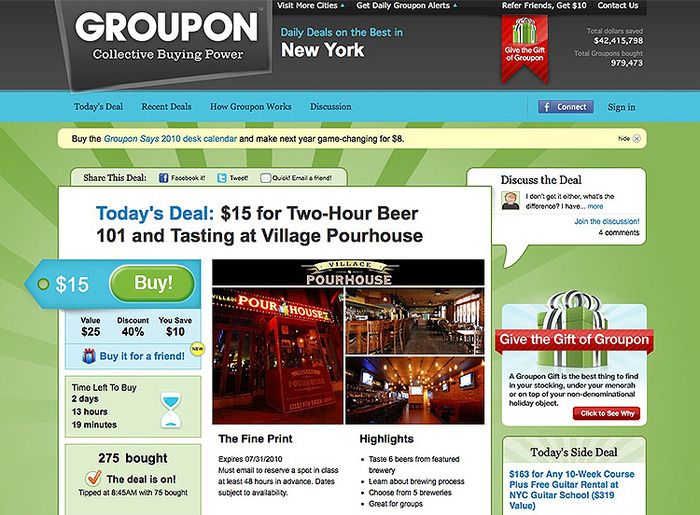
Groupon MVP
The idea here is very simple. Getting in a loop of endless product development and improvement requires many resources. And here’s what may happen:
- You’ll be polishing a Product that people don’t need or aren’t ready to pay for. Instead, you could pivot or iterate your idea at the early stages and really get the most out of available resources.
- There may be other people working on a similar idea. Launching first may be your big competitive advantage.
💡 Lesson # 6: Look at how people hack your or existing solutions. Pick a niche.
The Point was about getting people together around some ideas. However, the concept itself was too abstract. Projects, even if they seemed ambitious, didn’t get enough support.
The reason for that was because there was just too much of everything right from the start. Charity fundraising, kickstarting, campaigning attracted people with different needs and interests, making none of these successful.
But let’s back to the lesson you can get out of Groupon’s Minimum Viable Product case study.
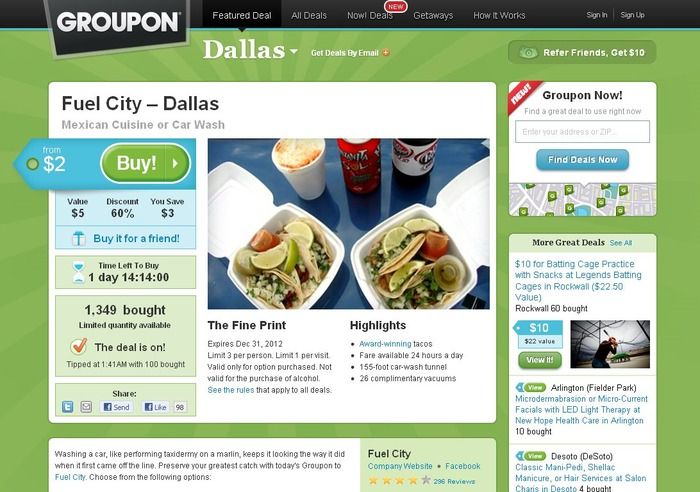
An advanced version of the Groupon website
The Groupon concept hit Andrew when he noticed that the big deal of people uses The Point for collective buying. So instead of keeping all the eggs in one basket, he decided to focus on this exact feature.
They would be curating and handpicking these campaigns on their own. Moreover, users would only receive 1 offer a day in their email box. Thus, it would be possible to channel the whole user base into one thing and get enough people to make a success. And it did!
Focusing on a specific niche will help you to deliver the ultimate experience to your users and solve a very specific problem for them. That’s exactly what the most of Minimum Viable product famous examples are about.
Moreover, if people start using your Product not the way you meant it, consider this as an opportunity to review and pivot your concept.
📆 Buffer: Test Before Coding
This service is one of the best Minimum Viable Product examples that show how you can validate your idea before writing a single line of code.
The Story 📖
Everything has started with a small idea. Joel Gascoigne, Buffer’s founder, had a Twitter account for tech & startup news. An increasing audience on his channel inspired him to tweet more. However, it was difficult to keep up the pace since you either had to spam your users with a bunch of tweets at once or visit the app many times throughout the day to post them regularly.
That was how Joel Gascoigne came up with an idea of the social media scheduling application. Simple as that.
Back at that time, he was already an advocate of Eric Ries’ Lean Startup principles. He learned a lot about the MVP concept while working on his first Startup. Yet, this time Joel wanted to adhere to its principles as much as he could.
Now you can probably guess that he’s succeeded. After all, that’s why Buffer often ends up on the lists of the best Minimum Viable Product examples.
Joel even started codding Buffer before he even tested the idea. However, since he promised himself to do everything right this time, he stopped coding and decided to gather feedback first.
So he created a 2-page MVP you can see below:
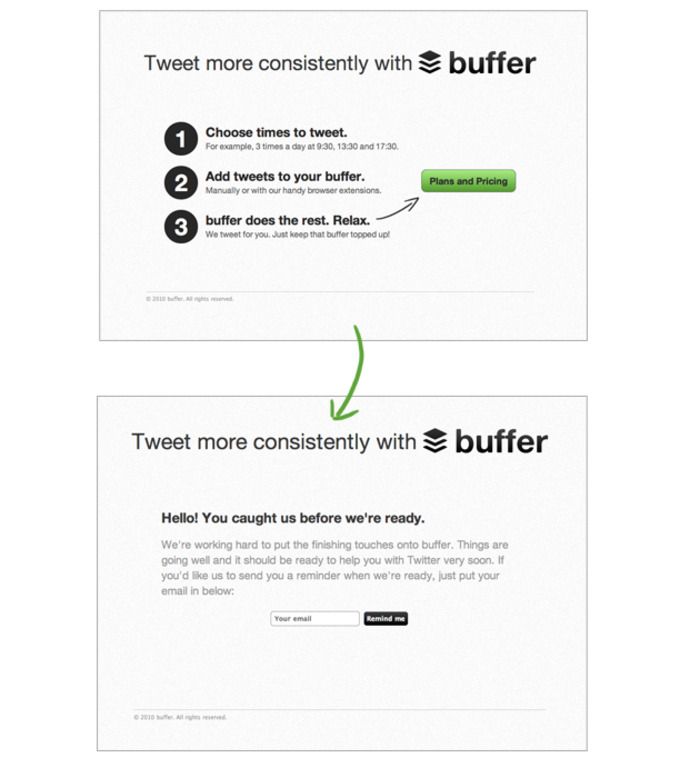
At first, the Buffer MVP looked like this
The aim was simple: to check whether someone at all needs such an app. Joel simply tweeted the link to ask what others think about it and waited.
Soon he got a few emails and Twitter messages with feedback. Moreover, some people have even left their email addresses in order to get notified when the app is out. Joel considered this to be enough for the first “validated learning”.
Then he decided to add a pricing screen to learn more about his customers. These 3 pages make up one of the most popular Minimum Viable Product website examples:
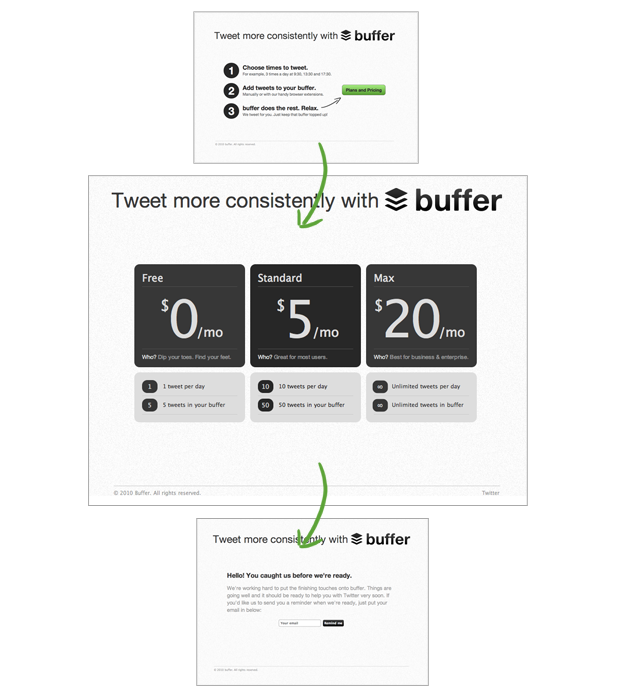
Eventually, Joel added one more page to his MVP
By showing pricing options he was able to verify whether people were ready to pay for the solution. After validating this idea, he finally moved on to development itself.
It took 7 weeks to create the first version of Buffer. However, Joel usually coded in the evening and weekends so it could be done faster.
The Lessons 👩🎓
Buffer is one of the classic Minimum Viable Product website examples. Here’s what we can learn from it.
💡 Lesson # 7: If possible, test your idea before you even start coding.
This lesson could be considered as one of the basic MVP development principles. If it’s possible to get any feedback on your idea before you write a single line of code, do it!
However, keep in mind that there’s a huge gap between “I will buy your product” and the actual purchase. 100 people that have signed up for updates likely won’t turn into 100 customers but at least it shows that they’re interested in your idea.
On the other hand, if your concept has no support right from the start, it’s a vivid sign that you need to pivot.
As Buffer’s and Airbnb’s Minimum Viable Product examples show, one of the best ways to test the idea without starting to build the Product itself is by creating a landing page.
💡 Lesson # 8: Keep your product really minimal.
Today in Buffer you can schedule posts for Twitter, Instagram, Facebook, and Linkedin. Also, you can engage with comments, automate answers, get analytics and reports.
However, the first version of Buffer allowed only scheduling tweets. Yet, it was enough to attract some users, validate the idea and only then — scale.
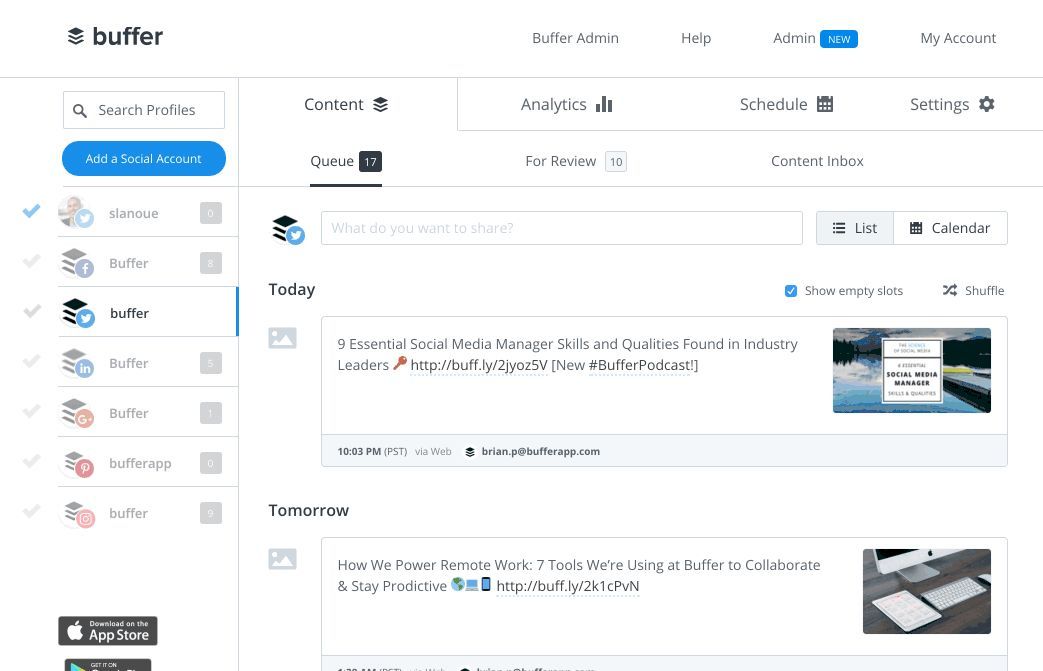
The MVP was quite different from the current version of Buffer
For young Startups, it may be tempting to build the best product they can. Often it may seem like the existing version of the product isn’t good enough.
Yet, keeping your product minimal is enough to validate the initial idea and align your product development with the needs of the audience.
Evan Williams, Twitter’s co-founder, shares the same opinion:
“Any time you're building a product, there are a million things you want to add to make it better, but the fact is the vast majority of them will not impact your success. It's more important to make those decisions well than it is to figure out how to increase productivity so you can add more and more.”
🚕 Uber: Scale Gradually
Finally, we couldn’t miss adding Uber on our list of the best Minimum Viable Product examples. Here’s why!
The Story 📖
The story of Uber takes us back to San Francisco. Just like hotels (which you could learn from the Airbnb’s Minimum Viable Product case study), taxies were another expensive thing about the city. Having got frustrated by high prices and the absence of affordable alternatives, Travis Kalanick and Garrett Camp came up with the idea of pairing drivers and passengers.
They launched the beta version of UberCab in 2009 and it was quite different from what we know now. However, this very first version of Uber soon got on the lists of examples of Minimum Viable Products. So what was it exactly?
- A PHP web application that looked like a mobile app (webview).
- You could order one from few cabs that were actually owned by the company.
- The app was available only in the San Franciso area and only on iPhones.
- However, you couldn’t download it from the App Store. To get the app, you should email any of the founders and receive a special code.
- In the very first version, you couldn’t pay right in the app. Yet, this feature was added after a few iterations at the beta stage.
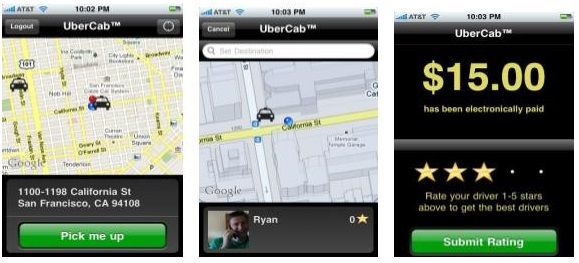
One of the first version of the Uber app
It’s also interesting to notice that at first all the orders were handled manually. Yet, after acquiring a few more cars the process turned out to be too difficult and resource-consuming. To solve this, Uber’s CEO contacted drivers and offered them to accept and manage orders on their own. 3 out of 10 agreed, giving a start to the business model that made it the #1 taxi app in the world.
The Lessons 👨🎓
The lessons you can get out of Uber’s MVP software examples сomplement the ones from previous cases.
💡 Lesson # 9: Pivots and iterations are ok.
Sometimes you may decide to change a part of your Startup when you’re already working on it. In general, these changes may refer to your problem or customers (pivot) or your solution (iteration).
While iterations make up the organic development of your product (as you add new features, for example), pivots are something not every Startup faces.
However, as you could see, Uber had to switch from its initial business model and establish a channel for direct communication between a driver and a customer. After all, this model has made Uber famous and even made its way to other industries.
💡 Lesson # 10: Scale gradually.
Most of the Startups mentioned in this article started small. They were available only in the home area of founders and were aimed at solving one specific problem.
First, such an approach lets you get out with the minimum waste of resources in case your product doesn’t go up.
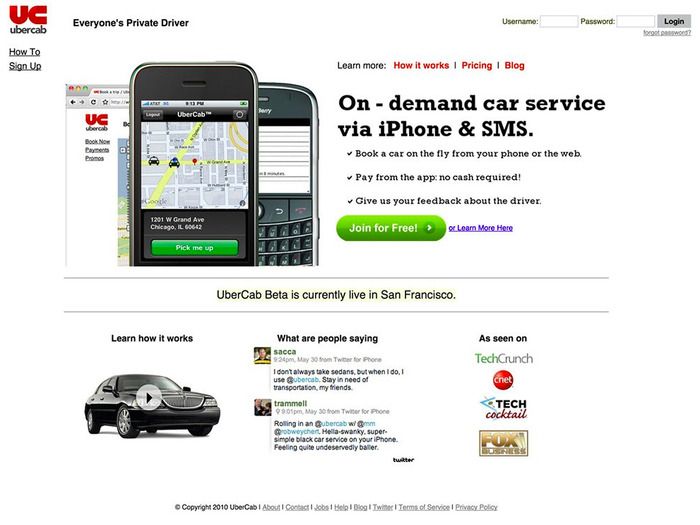
Uber's MVP website after a few iterations
Second, it keeps you focused on the problem you’re trying to solve instead of thinking about things that matter less. Actually, everything matters less than the problem.
Finally, it allows you to confirm assumptions and plan further product development based on the basis of proven information.
💡 Takeaways
That’s it! We hope that this article gave you at least a few handy ideas on your own Startup development.
Despite the mentioned Minimum Viable Product examples look different, they all prove the top 10 lessons we’ve highlighted:
- A successful MVP doesn’t mean a successful Product.
- MVP is usually used to validate a problem. However, you can also use it to validate the solution.
- A viral promo can help a lot.
- It’s good to have a personal relation to the problem you’re trying to solve.
- Keep your Time to Market short.
- Pick a niche.
- Test your idea before you start coding if it’s an option.
- Keep your MVP minimal.
- There’s nothing wrong with pivots and iterations.
- Scale gradually.
Looking for a Tech Partner in Crime to build your MVP? Drop us a line and we’ll do our best to build your next Web or Mobile Product!
Was it helpful?
Read also

Case Studies: Success Stories of Businesses That Built and Launched SaaS Applications

Case Study: How We Solve Technical Challenges for Our IoT, Mobility, and Fitness Clients

How to Monetize Your SaaS Product: Pricing Models and Strategies for Success
Our clients say
![Stormotion client Alexander Wolff, CPO from [object Object]](/static/a16ba3c9580effc3ab9a68d115eadffe/b0e74/alex.png)
When I was working with Stormotion, I forgot they were an external agency. They put such effort into my product it might as well have been their own. I’ve never worked with such a client-focused company before.
Alexander Wolff, CPO
Sjut
